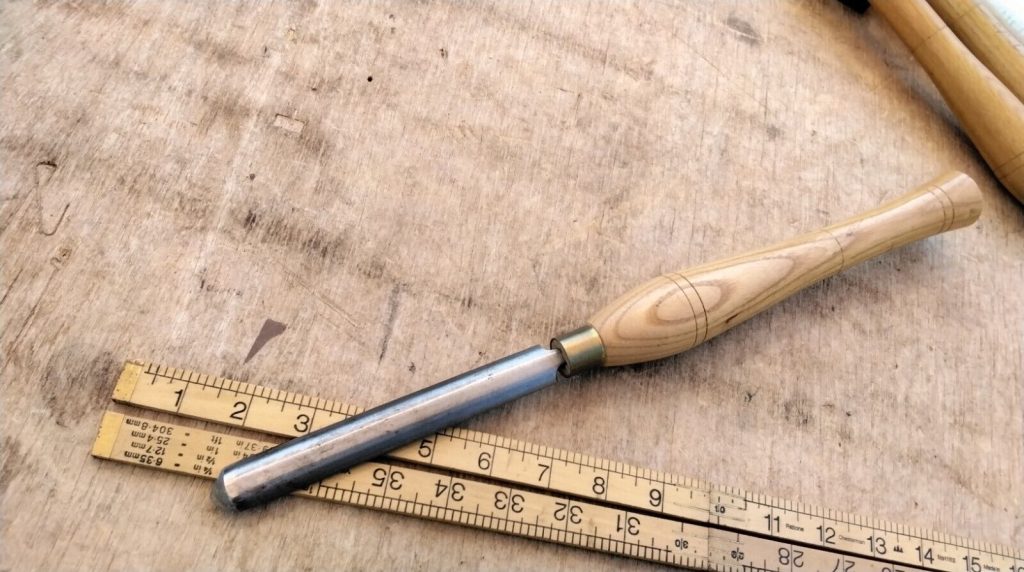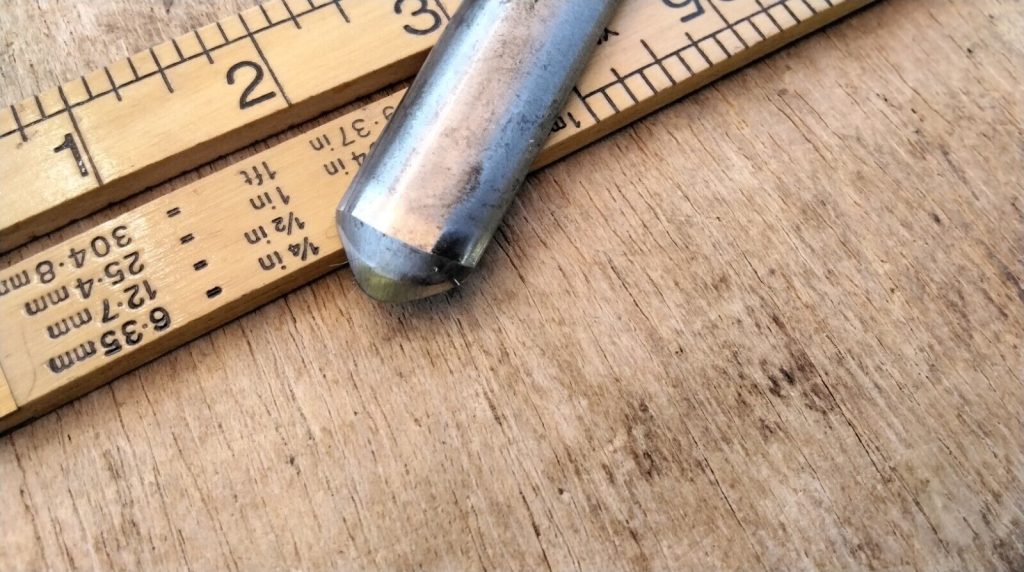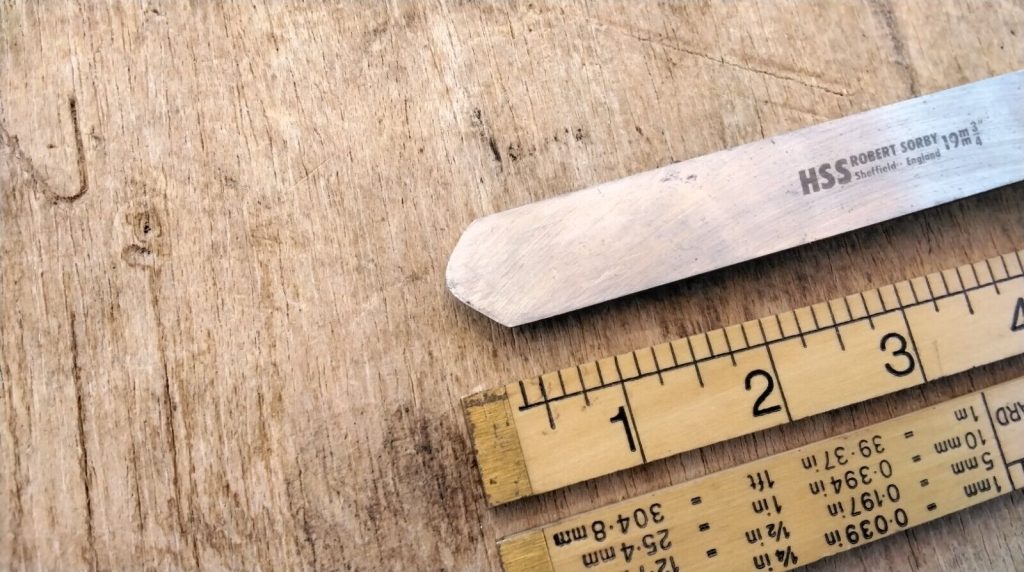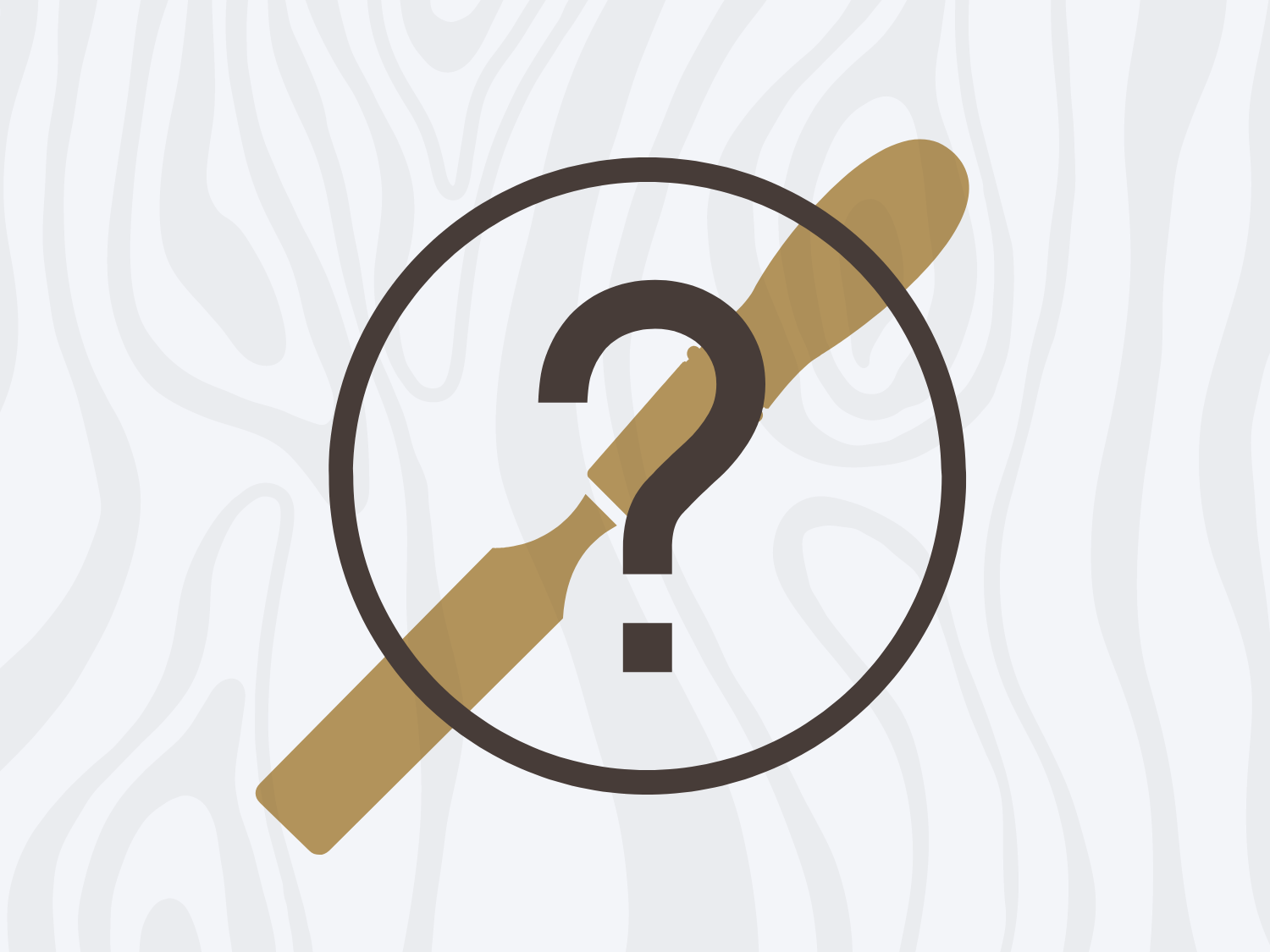The round nose scraper is great for removing high spots or tool marks quickly. The scraper can finely grade and create smooth flowing curves in a region to perfect a bowl layer thickness or help make ideal bowl interior bottoms with exercise and finesse.
When turning the inside of a bowl, the continuous cutting path along the inside bowl wall can vary in thickness slightly. It can be difficult to “repair” certain wall areas with the bowl gouge.
If the bowls gouge begins a cutting path and slightly as the depth of the cut in a bowl wall curve increases, the intended “repair” becomes much more complicated.
For a recommendation on best scrapers and other tools, see Best Full-Size Carbide Turning Tools.
Some woodturners have a saying, “just one more cut.” That phrase has several meanings, one of which is that “just one more cut” can ruin your other tools.

Round Nose Scraper Hacks
Angle of attack
The angle of attack is the first hack using a round nose scraper. When using T=the angle of the round nose scraper is vital to success. To begin, we must scrape the centerline with the scraping side of the large round nose scraper.
Although you can utilize the round nose scraper flawlessly horizontally at the centerline, the resulting wood bowl surface ground is visible.
Instead, you’ll raise the tool rest slightly above the center and then angle the downward at a 10 to 20-degree angle. This tool’s presentation reduces the impact angle and removes some of the impact energy that can easily rip wood fibers from the surface.
Tool rest up
Contact with the bowl’s interior surface should be near the centerline, with the rest slightly raised and the round nose scraper tilted downward.
Move the scraper gently until it makes the least contact possible. Pivot the device in left and right passes, depending on the size of the area.
Start by removing very thin layers at a time with each left-to-right pivot. This will help reduce tear-out and result in to create smooth flowing curves.
Deep cuts will almost certainly cause tears and the unpleasant barking sound I mentioned earlier. Finesse is essential.

Adding burr
Pull a burr along the sharp end grain of the bowl scraper with a burnishing tool. Wrap your hand around the scraper head, the burnishing tool pointed upward, and your thumb on top of the bar.
Drag the burnishing tool from across the scraper’s cutting edge in a single to create smooth flowing curves motion.
This will create a new, bigger burr on the scraper’s top edge. You should be able to tell the difference between honing and just honing by running your finger across the burr.
Secret move
Raise the rest slightly and angle the scraper downward after applying the extra burr to the scraper edge with the burnishing tool.
Instead of leaving the scraper’s bar flat against the tool rest, raise the right side (trailing edge) while the rest is in contact with the left side (cutting edge).
At this time, two perspectives are in play. The angle of the round nose scraper bar and the downward angle of the scraper’s head. Only a small portion of the scraper’s edge will now make contact with the bowl surface.
Scrape the turning tools bowls gently with the scraper until shavings appear. Yes, you heard correctly, shavings.
The hard part
The cutting action is the most difficult to master. Scraping will most likely occur before cutting because the burr angle varies, and the angle at which the scraper handle length is held while turning tools varies.
Before any curved burrs attach and start cutting, you may need to move the handle length to a slightly different angle.
Since the burr was manually implemented into the round nose scraper, its consistency may vary. You may connect and cut better in one nose area than in other tools. You are cutting when fine curly shavings come off the tip.
The presence of wood dust and debris indicates that the tool is still scraping, so it’s best that you avoid inhaling wood dust.
Even when scraping, the two images make a point of contact with the wood bowl turning, perfect for the smooth finish.
Continue to practice cutting with a scraper by using a continuous burr on the scraper and varying the angles at which you present the tool to the bowl.
When Should You Use a Scraper?
I consider the round nose scraper a specialty tool you only use when necessary. This tool is not used for every bowl.
When you’re stuck with a problem that appears difficult or impossible to solve with a bowl gouge, it’s a huge relief to remember the capabilities of the round nose scraper.
When you have an area of the bowl inside that isn’t cooperating, use the round nose scraper. This is usually because you weren’t paying attention to the depth of you’re cut and made the wall too thin in that area.
In addition, if you’re turning wood bowls, I’ll use a scraper to fine-tune the thickness of the walls after you’ve done as much as you can with your bowls gouge.

Types of Round Nose Scrapers
As the name suggests, the round nose scraper has a rounded cutting head. Under the cutting edge, this snipping area has a continuously curved bevel.
You can find an asymmetrical half-circle cutting edge or an asymmetrical centered on one side on round nose scrapers.
Round nose scrapers come in various widths and curve sizes and are made from high speed steel or hardened metal tight bars.
I’d recommend having a few different sizes on hand because each turning situation requires a specific-sized area to match.
A negative rake round nose scraper is similar to a regular round nose scraper but has an additional top bevel edge.
Since the downward “pre-angle” of the negative rake scraper, you can use it horizontally without producing the same harsh results as a standard scraper.
If desired, the negative rake scraper can also be angled downward to increase the approach angle.
Sharpening Round Nose Scraper
On your sharpening grinder, you’ll need an adjustable platform. This flat adjustable platform is part of the Oneway Wolverine Grinding Jig System. Another option is an individually adjustable grinding platform, such as this one.
Lay the scraper on the platform with the grinder turned off and adjust the angle until the contact with the grinding wheel is perfectly flat, then secure the platform.
Turn on the grinder and gently move the scraper along the wheel, keeping constant contact with the wheel’s bevel.
Scrape vs. Cut
Scrape
The surface of wood bowls is exactly what it sounds like: scraping. The scraper approaches the woodturning tools with a blunt solid edge at a steeper angle and tears the fibers away with a more or less controlled colliding action.
Cut
Cutting with a bowl gouge incorporates less severe angles to the wood grain, and the cutting action is much more akin to slicing than tearing.
Our ultimate goal is to soften the round nose scraper’s abrupt force and make it more like a bowl gouge’s cutting action.
Listening is one way to detect the differences between cutting and scrapping. It is typically much louder and more violent than cutting. Shear-scraping, which shaves away small blemishes, on the other hand, is almost silent.

Honing The Edge
Unless the sharp edge of the round bowl gouge is in desperate need of sharpening, you are not required to return to the grinder.
Rather than use a diamond hone to bring the scraper’s bevel back to life because it removes very little metal material, using the hone will extend the life of the scraper.
Maintain a firm grip on the scraper and move the hone down and up the bevel edge, ensuring that you keep the hone flush and interact flatly with the scraper’s bevel. Along the edge, the spindle work from left to right.
Frequently Asked Questions
How to put a burr on a scraper?
As shown on the left, a ‘burr’ is formed along the scraper’s edges using a very hard, high speed steel burnishing tool.
This is accomplished by firmly pressing the burnishing tool against the scraper and dragging it along its edge.
How to make a burr?
Sharpen the knife one side at a time to create a burr. If this is the first period the knife has been honed in a Wicked Edge sharpening machine, we recommend drawing the burr with your 200-grit stone. We recommend drawing the burr with your 600-grit stone if you’re touching up your edge.
Is scrape better than sanding?
A scraper, at its most basic, removes small amounts of material. It works especially well in difficult hardwood areas where traditional hand planes would cause tear-out. In many cases, we believe they are superior to sandpaper. It often results in a cleaner surface than sanding.
Conclusion
A burnishing tool is also essential for getting the most out of your scrapers. The burnishing tool is made of hardened high speed steel, and you can convert it by “pulling a burr” from across the round nose scraper’s edge from a scraper to a cutting tool that makes it super clean and create smooth flowing curves cut.
Scrapers are useful for refining surfaces outside and inside of a bowl. Round nose scrapers of various sizes are extremely useful for interior applications.
You can keep a variety of sizes on hand, including a 1-1/4′′ Round Nose Scraper, a 1-inch Round Nose Scraper, a 1/2′′ Round Nose Scraper and a 3/4′′ Round Nose Scraper.
